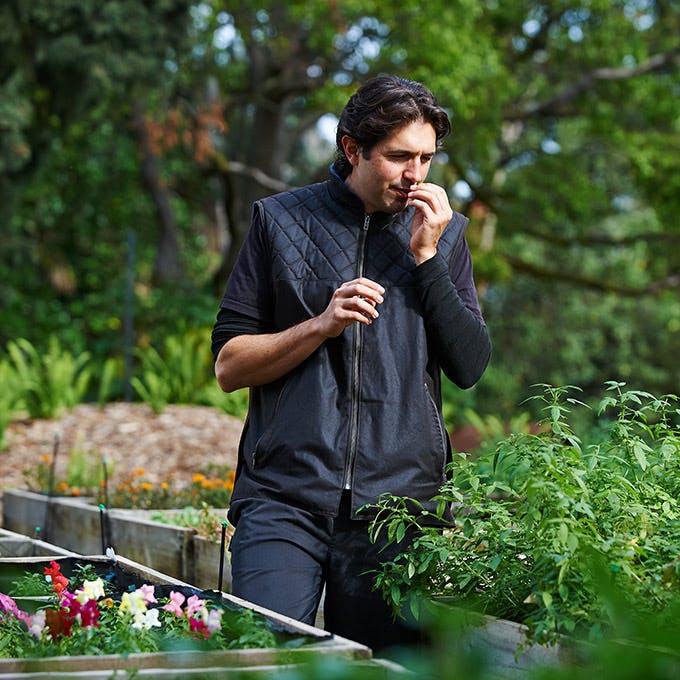Chef Ben Shewry's BBQ Tips
Grilling tips from Ben Shewry, Australia's most important chef
When one of Australia's biggest chefs invites you over for a BBQ, you accept—even if you have no idea what you're getting into. Grilled kangaroo? Shrimp on the barbie? After a lunch at Shewry's Melbourne restaurant, Attica, which features elegant dishes like emu egg sabayon, I am (ahem) game for anything.
Attica is one of those restaurants where you need to book months in advance, and even to get a seat, you must know someone. Highlighting unsung native Australian ingredients, Shewry has earned international acclaim, as Attica currently ranks number 32 on S.Pellegrino's World's 50 Best list. It is also the subject of the inaugural season of Chef's Table.
Ironically enough for a guy who has shaped his career around progressive Australian cuisine, Shewry isn't, in fact, an Aussie native—he's actually from New Zealand. Yet, foraging for ingredients on New Zealand's North Island as a child, which he describes as "no big deal, and just a very economical and delicious way to feed a family," has largely impacted his cooking today. "The flavor of Australian indigenous plants . . . manifests itself through ingredients that to some could be harsh tasting, but to me are fascinating representatives of the plant kingdom that challenge and push us every day," he explains.
 Chef Ben Shewry | Photo: Attica
Chef Ben Shewry | Photo: Attica
Needless to say, Shewry knows exactly where to find the best ingredients around. So when my dining partner at lunch, Alinea executive chef Mike Bagale, and I ask him where to find the best steak in Melbourne, we know we're in for good advice. What we don't expect is for him to answer, "My house."
That's how I end up at Shewry's house with the entire Alinea crew for a traditional Aussie-style barbecue.
—–
When we arrive, Shewry explains that the most classic of classic Australian grill-out foods are sausages, steaks, prawns, lamb and burgers—most of which we would try that evening. So, when two plastic bags of squishy white bread, basically the Australian equivalent of Wonder Bread, land on the kitchen island in front of me, I am a bit surprised.
"We have a large hardware chain here called Bunnings," Shewry begins. "In all Bunnings stores across Australia on Saturdays and Sundays, they have a charity sausage sizzle and everyone always gets a piece of white bread with a sausage, grilled onions and tomato sauce." So, naturally, we get the chef's take: fatty, freshly grilled pork sausages whose juices are saved by makeshift, hand-molded white bread buns.
Resisting the temptation to fill up on the grass- and saltbush-fed grilled lamb that comes next proves to be a smart decision, because once we all sit down to eat, the chef serves two enormous grass-fed, dry-aged tomahawk steaks from the Victorian Highlands; eight grass-fed, dry-aged "Wagyu" steaks from Tasmania; and another eight or so grass-fed, dry-aged steaks from Tasmania. Bear in mind, there are only 12 of us at the table, and we have already consumed two courses of meat during cocktail hour.
So when you're throwing your next BBQ, take notes from Down Under: Barbecues should involve multiple courses of meat, and you don't need to worry about organization. Focus on presenting high-quality ingredients, simply but properly cooked, and share those plates among your closest friends.
Here are some of Shewry's pro-tips for acing your next barbecue:
① Be prepared and organize everything you need before you start cooking.
② To ensure you cook the meat properly, make sure your grill is super hot. (Otherwise food might stick to the grill, or you might end up overcooking by keeping the meat on for too long.)
③ Just before cooking, brush the meat lightly with oil, and then season it liberally with salt on both sides. Note: If you salt it any earlier, the texture of the meat can change as the salt draws moisture to the surface.
④ Serve sausage with soft white bread as it's done at Bunnings. Though it may seem unorthodox, the bread serves as a vessel to catch the sausage's juices, saving your shirt and creating richer, more flavorful bites.
⑤ Start with a few high-quality proteins that can serve as the meal's anchor and work from there. Next, consider accompanying produce that's at its peak season. If you start with perfectly ripe ingredients, they'll be so delicious on their own that they won't need much prep, cutting down on your own cooking. If corn is in season, throw a few ears on the grill. If it's tomato time, slice up a handful and simply toss them with good olive oil and sea salt.
⑥ Don't over think things. Barbecues are meant to be fun and super casual. Have a beer while cooking. Also, have all your mates around.
Whether your idea of the perfect picnic is cooking in the wilderness or sipping a summery cocktail at a sidewalk café, we've got everything you need to spend your Summer in the Wild. Let the outdoor entertaining begin.
Photo: Devon Knight












